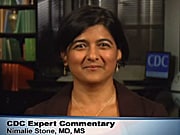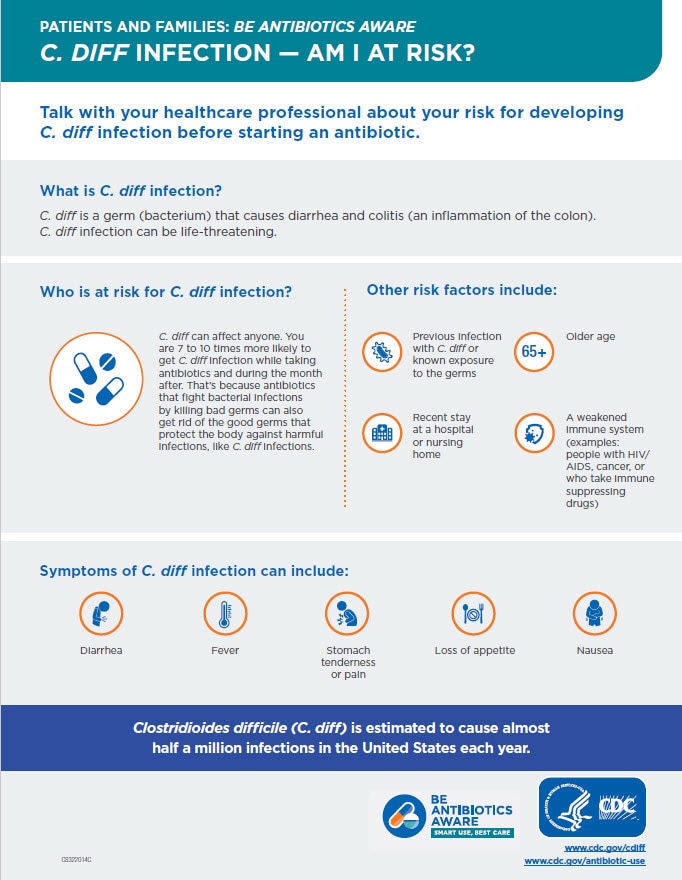C. diff Guidelines and Prevention Resources
On This Page
Antibiotic Use Resources
- Be Antibiotics Aware (formerly Get Smart about Antibiotics) is a national effort to help fight antibiotic resistance and improve antibiotic prescribing and use.
- Core Elements of Hospital Antibiotic Stewardship Programs
Related Guidance from Professional Organizations and Partners
- Duration of Contact Precautions for Acute-Care Settings (SHEA)external icon
- Clinical Practice Guidelines for Clostridium difficile Infection in Adults and Children: 2017 Update by the Infectious Diseases Society of America (IDSA) and Society for Healthcare Epidemiology of America (SHEA)external icon
- Strategies to Prevent Clostridium difficile Infections in Acute Care Hospitals: 2014 Updateexternal icon
- Rationale for Hand Hygiene Recommendations after Caring for a Patient with Clostridium difficile Infection pdf icon[PDF – 3 pages]external icon
- Guide to Preventing Clostridium difficile Infections pdf icon[PDF – 100 pages]external icon
- Clostridium difficile Infection in Infants and Children (AAP)
- CDI Guide to Patient Safety Tool (STRIVE) [PDF –27 pages]external icon
CDC Expert Commentaries
Podcast: Annals On Call – C. difficile: The Most Common Health Care–Associated Infection in the United States
Drs. Allison Guh and Preeta Kutty discuss the prevention, diagnosis, and treatment of infection with C. difficile.

Core Elements of Antibiotic Stewardship for Nursing Homes
Dr. Nimalie Stone talks about antimicrobial stewardship in nursing homes. Improving the use of antibiotics to protect patients and reduce the threat of antibiotic resistance is a national priority.
Publications
- Guh AY, Mu Y, Winston LG, Johnston H, Olson D, Farley MM, Wilson LE, Holzbauer SM, Phipps EC, Dumyati GK, Beldavs ZG, Kainer MA, Karlsson M, Gerding DN, McDonald LC. Trends in U.S. Burden of Clostridioides difficile Infection and Outcomes. N Engl J Med 2020; 382:1320-1330. https://doi.org/10.1056/NEJMoa1910215
- CDC. Antibiotic Resistance Threats in the United States, 2019. Atlanta, GA: U.S. Department of Health and Human Services, CDC; 2019. http://dx.doi.org/10.15620/cdc:82532
- Making Healthcare Safer: Stopping C. difficile Infections. CDC Vital Signs. March 2012. https://www.cdc.gov/vitalsigns/hai/stoppingcdifficile/index.html
- Guh AY, Kutty PK. Clostridioides difficile Infection. Ann Intern Med. 2018; 169(7):ITC49-ITC64. https://doi.org/10.7326/AITC201810020
- Guh AY, Adkins SH, Li Q, Bulens SN, Farley MM, Smith Z, Holzbauer SM, Whitten T, Phipps EC, Hancock EB, Dumyati G, Concannon C, Kainer MA, Rue B, Lyons C, et al. Risk Factors for Community-Associated Clostridium difficile Infection in Adults: A Case-Control Study. Open Forum Infect Dis. 2017; 4(4):ofx171. https://doi.org/10.1093/ofid/ofx171.
Page last reviewed: June 27, 2022

